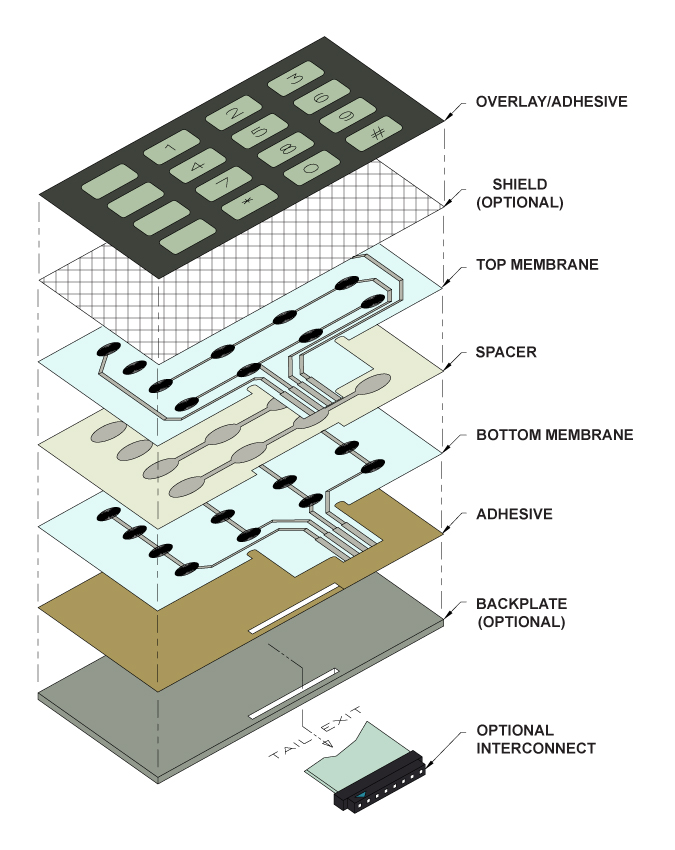How Membrane Switches Are Critical for Efficient Control in Medical Instruments
How Membrane Switches Are Critical for Efficient Control in Medical Instruments
Blog Article
Why Membrane Layer Switches Over Are Important for Sturdy Control Systems
Membrane layer switches play a critical duty in ensuring the toughness and integrity of control systems throughout various markets. As we check out the complex benefits of membrane buttons, it becomes noticeable that their value goes beyond simple capability, influencing customer experience and operational performance.
Summary of Membrane Switches
Membrane switches are flexible and reliable components generally utilized in numerous digital control systems. These buttons contain a number of layers, consisting of a visuals overlay, a spacer layer, and a printed circuit layer. The visuals overlay gives both practical and aesthetic layout, while the spacer layer makes sure that the buttons are activated just when pushed. The printed circuit layer includes conductive traces that complete an electric circuit when the membrane layer is pushed, making it possible for the tool to reply to individual inputs.
Membrane layer buttons are usually preferred in applications calling for a compact and light-weight design, making them optimal for portable gadgets, clinical devices, and commercial equipment. They can be personalized to fulfill certain user requirements and can incorporate various features such as backlighting, responsive responses, and multiple shades. Membrane layer buttons are immune to dust, dampness, and impurities, making them ideal for environments where resilience is essential.
Advantages of Sturdiness
In many applications, the longevity of membrane layer switches over deals substantial advantages that enhance their overall efficiency and dependability. These buttons are designed to stand up to severe settings, making them perfect for usage sought after problems such as high humidity, extreme temperatures, and direct exposure to chemicals. Their robust building and construction aids to avoid damages from physical influence, guaranteeing resilient performance and lessening the need for regular replacements.
Furthermore, membrane switches are immune to wear and tear, which is vital in applications where frequent communication happens. This durability translates to decrease maintenance prices, as companies profit from decreased downtime and less solution disruptions. The encapsulated design of membrane changes secures interior parts from dirt and wetness ingress, additional adding to their lifespan (membrane switch).
An additional benefit is their ability to maintain constant efficiency in time. With a high tolerance for mechanical anxiety, these buttons protect their responsive responses and electrical honesty, ensuring user fulfillment. Inevitably, the resilience of membrane changes not only boosts operational efficiency yet likewise fosters self-confidence in their dependability, making them a recommended selection for control systems across numerous industries.
Applications in Various Industries
Durable control systems utilizing membrane switches discover substantial applications across a series of markets, each profiting from the distinct qualities these switches provide. In the medical sector, membrane switches are vital for gadgets such as patient monitors and diagnostic equipment, where dependability published here and ease of cleaning are extremely important. Their resistance to moisture and impurities guarantees they preserve performance in sterilized environments.
The vehicle sector leverages membrane layer switches for dashboard controls and infomercial systems, where they offer smooth, low-profile interfaces that boost customer experience. These buttons are also designed to stand up to severe problems, including direct exposure to severe temperature levels and resonances.
In imp source industrial settings, membrane layer buttons are generally made use of in machinery control panels, using tactile comments and longevity essential for high-usage applications. Their capacity to resist chemicals makes them appropriate for making atmospheres where spills and impurities are regular.

Consumer electronic devices, such as kitchen appliances and remotes, additionally make use of membrane layer buttons for their flexibility and cost-effectiveness. On the whole, the adaptability and durable nature of membrane layer switches make them essential across various markets, making certain effective procedure and durability in control systems.
Style and Visual Allure
While capability is extremely important, the style and aesthetic allure of control systems furnished with membrane layer switches play an important duty in customer involvement and general experience (membrane switch). The visual design of these buttons can significantly influence customer perception and interaction. A well-designed membrane layer button improves the attractiveness of the device, making it a lot more appealing to individuals and cultivating a link in between the individual and the item
Membrane layer changes offer a lot of flexibility in style, allowing producers to tailor graphics, colors, and textures to line up with brand name identification and item looks. Using vivid shades and unique patterns can draw interest, while tactile responses can enhance the individual's interaction with the gadget. In addition, the capacity to integrate LED indicators and backlighting see this site right into the membrane layer switch design gives both functional and aesthetic benefits, improving visibility and functionality in various environments.

Enhancing User Experience

Additionally, membrane switches can be customized to incorporate visual interfaces, improving use by presenting information in a clear and intuitive way (membrane switch). This customization can consist of symbols, tags, and color coding that overview users with facility performances easily. Furthermore, their adaptability enables integration in numerous environments, making certain consistent performance whether in industrial equipment or customer electronic devices
The durability of membrane switches likewise plays an essential duty in individual experience. By standing up to extreme conditions and expanded use, these switches decrease the likelihood of system failures, thus advertising dependability and customer self-confidence. Ultimately, the critical use membrane layer changes not just elevates capability yet additionally significantly improves individual interaction with control systems, making them a crucial element in contemporary style.
Final Thought

Report this page